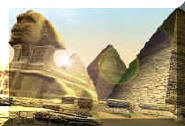| |
Giza: l'enigma della grande piramide
 Percorrendo il lungo pendio che conduce all’altopiano di Giza, nei pressi del Cairo, pare di
scorgere in lontananza tre montagne dai contorni particolarmente
nitidi. Man mano che ci avviciniamo, però, riconosciamo quelle
gigantesche forme per quello che sono: piramidi. Ed una volta giunti
a ridosso la loro mole è ancora più impressionante. Lo spazio visivo
è occupato per metà dalla pietra e per metà dal cielo. La più alta è
la Grande Piramide di Cheope. La centrale appartiene a Chefren ed è
solo leggermente più piccola, mentre la più bassa è la tomba di Micerino.
Percorrendo il lungo pendio che conduce all’altopiano di Giza, nei pressi del Cairo, pare di
scorgere in lontananza tre montagne dai contorni particolarmente
nitidi. Man mano che ci avviciniamo, però, riconosciamo quelle
gigantesche forme per quello che sono: piramidi. Ed una volta giunti
a ridosso la loro mole è ancora più impressionante. Lo spazio visivo
è occupato per metà dalla pietra e per metà dal cielo. La più alta è
la Grande Piramide di Cheope. La centrale appartiene a Chefren ed è
solo leggermente più piccola, mentre la più bassa è la tomba di Micerino.
I sovrani egizi, i faraoni, si
ritenevano degli esseri viventi destinati un giorno a lasciare la
Terra per ricongiungersi alle altre divinità, ed in particolare al
dio del sole Ra, il più importante fra tutti gli dei, che
ogni giorno percorreva il cielo con la sua “barca di milioni di
anni” fiammeggiante e che di notte attraversava l’insidiosa oscurità
del mondo sotterraneo. Per affrontare la nuova vita nell’aldilà si
facevano costruire apposite dimore ai margini dell’altipiano
desertico, situate strategicamente tra il Nilo, dispensatore di vita
e l’orizzonte occidentale dove il sole ogni sera scompare. In un
primo tempo queste “dimore funebri” venivano edificate sottoforma di
veri e propri palazzi con locali pubblici, magazzini e case
destinate ai cortigiani destinati a seguire il loro padrone anche
nella morte. Intorno al 2700 a.C. il re Zoser fece edificare una
prima rudimentale piramide a gradoni che rappresentava una scala per
arrivare in cielo, a sud di Giza.
 Orione sarebbe collegato alla grande piramide.
I suoi successori svilupparono questa nuova forma piramidale fino alla tipica forma a superficie
liscia, portata al massimo splendore da Cheope, Chefren e Micerino.
Orione sarebbe collegato alla grande piramide.
I suoi successori svilupparono questa nuova forma piramidale fino alla tipica forma a superficie
liscia, portata al massimo splendore da Cheope, Chefren e Micerino.
L’era della costruzione delle Grandi Piramidi si protrasse per tutto l’Antico Regno
(2700-2200 a.C. ca.) e la piramide
di Cheope fu completata molto probabilmente verso il 2500 a.C.
Successivamente i faraoni abbandonarono le imponenti piramidi per
progettare nuove strutture, come piramidi più piccole di mattoni di
fango rivestite in pietra, templi o le famose tombe nella Valle dei
Re, dove venne sepolto Tutankhamon.
Secondo vari archeoastronomi la loro disposizione
rispecchia quella delle tre stelle della costellazione di Orione


In ogni caso la Grande Piramide di
Giza, Akhet Khufu, “lo Splendore di Khufu”, resta la più
bella in assoluto. Come siano riusciti gli antichi Egizi ad
edificare una struttura occupante un’area di 5,3 ettari, che si
innalza verso il cielo per circa 145 metri, composta da due milioni
e mezzo di massi calcarei e che complessivamente pesa 6 milioni di
tonnellate, non è ancora del tutto chiaro, anche perché
sull’argomento, stranamente, non sono rimaste moltissime
testimonianze. Di sicuro gli architetti dovevano essere ben versati
nelle scienze matematiche, dato che le proporzioni e le misure della
piramide sono straordinariamente precise.
I quattro lati del monumento sono orientati verso i punti cardinali con un’approssimazione inferiore
ad un decimo di grado. La differenza fra il lato più lungo e quello
più corto non supera i 20 centimetri. La pavimentazione che circonda
la Grande Piramide è perfettamente piana, considerando che
l’oscillazione massima nei punti più alto e più basso è di 2,5 cm.
Tale perfezione di calcolo fu probabilmente raggiunta attraverso
l’utilizzo di semplici aste di misurazione e corde, allineate
osservando il sole e le stelle, e forse anche con l’uso di livelle
ad acqua per le linee orizzontali. Ad ogni modo come sia stato
possibile con strumenti così elementari raggiungere un perfezione
metrica, forse impensabile anche ai giorni nostri considerata
soprattutto la mole della struttura, resta un mistero.
I risultati di tutte le altre misurazioni hanno portato, inoltre, alla convinzione che la Grande
Piramide, in realtà, sia stata progettata come un gigantesco schema
del tempo, in attesa di essere interpretato dalla civiltà future. Ad
esempio dividendo il perimetro della struttura per il doppio della
sua altezza si ottiene 3,1416 ovvero l’attuale valore di Pi Greco.
La somma dei lati di base della piramide indica il numero dei giorni
di un anno, ossia 365,240 pollici egiziani antichi. L’altezza
moltiplicata per dieci milioni dà come risultato la distanza
approssimata tra il sole e la terra. Raddoppiando la lunghezza dei
quattro lati della piramide otteniamo quasi esattamente la misura
equivalente un sessantesimo di grado alla latitudine dell’equatore
(in metri la cifra corrisponde a 1842,92 mentre la cifra attuale è
di 1842,78). Se si sceglie un raggio pari alla sua altezza e si
traccia in base a questo una circonferenza, l’area del cerchio così
ottenuto è uguale all’area del quadrato di base. L’inclinazione
dell’asse di rotazione della terra nello spazio varia tutti i giorni
e non raggiunge la posizione originale se non una volta ogni 25827 anni.
Questa cifra, quasi esatta (25826,26), risulta tra le misure della piramide sommando le
diagonali della base. Le pietre che compongono il nucleo centrale
della piramide provenivano tutte dall’altopiano di Giza: la Sfinge
di Chefren sorge proprio sui resti di un’antica cava. Gli altri
materiali provenivano invece da cave vicino al Nilo, tipo la pietra
calcarea di Tura o il granito, che era originario addirittura di Assuan, 800 km verso sud.
Si calcola che la costruzione di questo fantastico monumento sia durata circa trent’anni e che abbia
impiegato, complessivamente, circa quattromila uomini, fra muratori e costruttori.
A differenza di altri antichi monumenti egizi, la Grande Piramide contiene vani e corridoi anche
nelle parti alte della struttura. Attraverso un’entrata praticata
appena sopra la base, al centro del lato nord, si accede ad uno
stretto passaggio che scende in una camera scavata nella roccia
sotto al monumento. Sempre dallo stesso passaggio parte un altro
corridoio che, invece, sale fino a sboccare prima in un piccolo
vano, denominato Camera della Regina, e poi nella Grande Galleria,
un immenso corridoio inclinato alto 8 metri e lungo 48, che a sua
volta porta fino alla Camera del Re, la stanza più imponente, che contiene un cofano a sarcofago.
Per 3000 lunghi anni l’interno della piramide è rimasto inviolato. Fu solo nel 820 d.C. che una
spedizione archeologica riuscì finalmente ad individuarne l’entrata.
All’interno, anche il corridoio ascendente era stato chiuso e
nascosto attraverso l’utilizzo di blocchi di granito. Dopo aver
aperto un varco attorno ad essi, la spedizione raggiunse la Camera
del Re solo per scoprire che il sarcofago del faraone era vuoto.
Ancora oggi nessuno può sapere con esattezza quale fosse la reale
destinazione della Grande Piramide, a parte il fatto di essere il
prodotto di numerosi e precisi calcoli matematico-astronomici.
|


